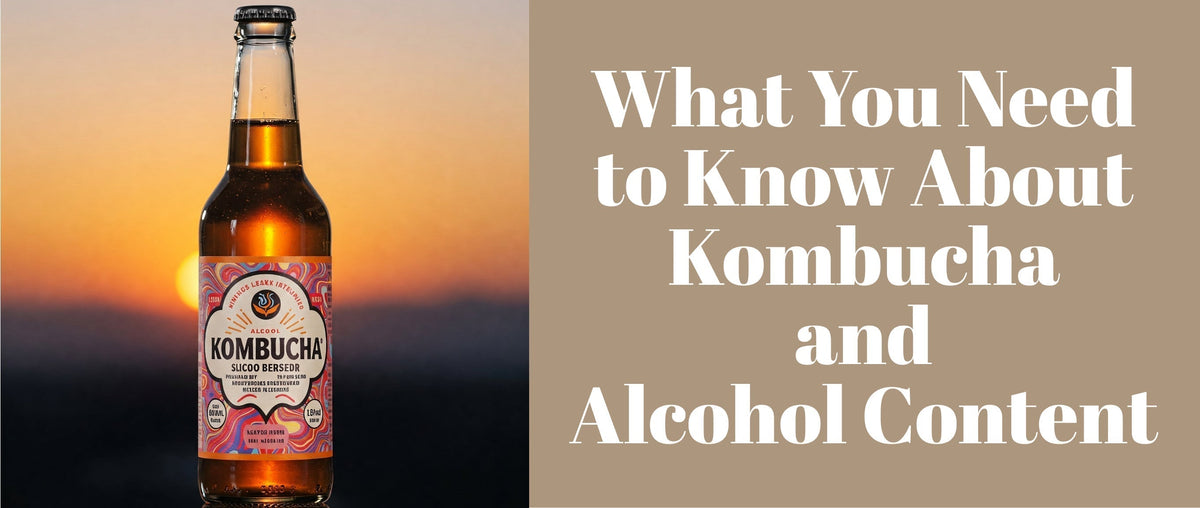The Ultimate Guide to Brewing Kombucha at Home
Kombucha is a fermented tea that has gained popularity due to its health benefits, probiotic content, and refreshing taste. This healthy drink is rich in antioxidants, aids digestion, and boosts immunity. Many people have started brewing kombucha at home because it is cost-effective, allows for customized flavors, and ensures quality control over the fermentation process.
Brewing kombucha may seem intimidating, but with the right ingredients, equipment, and step-by-step guidance, it becomes an easy and enjoyable process. Whether you're on a vegan diet, looking for cholesterol-free foods, or simply want a probiotic-rich drink, this guide will walk you through everything you need to know about brewing kombucha at home.
What is Kombucha?
Kombucha is a fermented tea that has gained popularity due to its health benefits, probiotic content, and refreshing taste. This healthy drink is rich in antioxidants, aids digestion, and boosts immunity.
Many people have started brewing kombucha at home because it is cost-effective, allows for customized flavors, and ensures quality control over the fermentation process.
Brewing kombucha may seem intimidating, but with the right ingredients, equipment, and step-by-step guidance, it becomes an easy and enjoyable process. Whether you're on a vegan diet, looking for cholesterol-free foods, or simply want a probiotic-rich drink, this guide will walk you through everything you need to know about brewing kombucha at home.
Health Benefits of Kombucha
- Supports gut health – Rich in probiotics that promote digestion.
- Boosts immunity – Contains antioxidants that protect against free radicals.
- Aids in detoxification – Helps the liver flush out toxins.
- Regulates metabolism – Can support weight management when combined with a balanced vegan diet.
- Improves digestion – Works similarly to apple cider vinegar drinks by balancing stomach acidity.
Kombucha is also a great alternative to processed sugary sodas, making it an ideal choice for those who prefer healthy drinks.

Understanding the SCOBY: The Heart of Kombucha
The SCOBY (Symbiotic Culture of Bacteria and Yeast) is the essential component of kombucha brewing. It is a thick, rubbery disc that floats on top of the fermenting tea and facilitates the fermentation process. The SCOBY feeds on sugar and transforms the tea into a tangy, probiotic-rich beverage.
How to Get a SCOBY
- Purchase from a trusted supplier – Many online stores sell high-quality SCOBYs with starter tea.
- Get from a friend – If someone you know brews kombucha, they can give you a SCOBY baby from their existing batch.
- Grow your own – You can create a SCOBY using store-bought, raw, unflavored kombucha.
Caring for Your SCOBY
- Keep it in a clean environment – Contamination can ruin the entire batch.
- Store it properly – If not in use, keep the SCOBY in a jar with some kombucha at room temperature.
- Check for mold – While uncommon, mold can form if the SCOBY is exposed to contaminants. Discard immediately if mold appears.
Essential Ingredients for Brewing Kombucha
To make homemade kombucha, you need a few simple ingredients:
1. Tea
Tea provides the necessary nutrients for fermentation. The best options include:
| Tea Type | Characteristics |
|---|---|
| Black Tea | Rich in nutrients, creates strong fermentation |
| Green Tea | Lighter flavor, slightly milder fermentation |
| Oolong Tea | Balanced between black and green tea flavors |
| White Tea | Delicate and smooth, lower caffeine |
Avoid flavored teas with oils, such as Earl Grey, as they can harm the SCOBY.
2. Sugar
Sugar is the food source for the SCOBY, not a sweetener. Some great options are:
- Cane Sugar – The most common and effective choice.
- Organic Sugar – Unrefined and healthier than processed sugar.
- Coconut Sugar – Alternative for those who prefer a plant-based option.
3. Starter Tea
Starter tea is previously brewed kombucha that helps kickstart fermentation. It ensures the pH level is correct and prevents harmful bacteria from forming.
4. Water
Use filtered or spring water for the best results. Tap water with chlorine can damage the bacteria in the SCOBY.
Essential Equipment for Brewing Kombucha
To successfully brew kombucha at home, you’ll need the right equipment. Using high-quality tools ensures a safe and efficient fermentation process.
1. Fermentation Jar
A glass jar is the best container for brewing kombucha. Avoid plastic or metal, as they can react with the acidity of the tea.
Recommended Size:
- 1-gallon glass jar – Ideal for beginners.
- 2-gallon glass jar – Perfect for continuous brewing.
2. Cloth Cover and Rubber Band
Kombucha requires oxygen for fermentation, so covering the jar with a breathable cloth (such as cheesecloth) is necessary. A rubber band secures the cover and prevents dust or pests from entering.
3. Wooden or Plastic Spoon
A wooden or plastic spoon is ideal for stirring, as metal can damage the SCOBY.
4. Bottles for Second Fermentation
For carbonation, use airtight glass bottles. These allow the kombucha to develop fizz during the second fermentation.
| Bottle Type | Pros |
|---|---|
| Swing-top glass bottles | Best for carbonation, reusable |
| Mason jars | Easy to use but may not retain carbonation |
| Plastic bottles | Not recommended; can leach chemicals |
Step-by-Step Brewing Process
Now that you have the ingredients and equipment, let’s get started on the kombucha brewing process.
Step 1: Prepare the Sweet Tea Base
- Boil 4 cups of filtered water.
- Add 4-6 tea bags (black, green, or oolong tea).
- Steep for 5-10 minutes, then remove the tea bags.
- Stir in 1 cup of sugar until fully dissolved.
- Add 8 cups of cold filtered water to cool the mixture.
Step 2: Add the SCOBY and Starter Tea
- Pour the sweet tea into a clean fermentation jar.
- Add 1-2 cups of starter tea.
- Gently place the SCOBY on top.
- Cover with a cloth and secure with a rubber band.
Step 3: Ferment the Kombucha (First Fermentation)
- Place the jar in a warm, dark place (70-80°F or 21-27°C).
- Let it ferment for 7-14 days.
- After a week, taste the kombucha. If it’s too sweet, let it ferment longer.
Also Read
Second Fermentation for Flavor and Carbonation
After the first fermentation, your kombucha is ready to drink, but if you want carbonation and added flavors, you need a second fermentation.
How to Bottle and Flavor Kombucha
- Remove the SCOBY – Take out the SCOBY and store it in a separate jar with 1-2 cups of kombucha for your next batch.
- Pour the kombucha into bottles – Use swing-top glass bottles for the best carbonation. Leave 1-2 inches of space at the top.
- Add flavoring – Choose from a variety of ingredients to enhance the taste.
Best Flavoring Combinations
| Flavoring Ingredients | Taste Profile |
|---|---|
| Fresh Ginger + Lemon | Classic, refreshing, and tangy |
| Strawberries + Basil | Sweet with a hint of herbal freshness |
| Mango + Turmeric | Tropical and slightly earthy |
| Apple + Cinnamon | Warm and fruity, great for fall |
| Pineapple + Mint | Light, tropical, and refreshing |
- Seal the bottles and ferment – Let them sit at room temperature for 3-7 days to build carbonation.
- Refrigerate before drinking – This stops fermentation and keeps the kombucha fresh.
Kombucha Storage and Maintenance
How to Store Finished Kombucha
- Keep bottled kombucha in the refrigerator to slow down fermentation.
- Consume within 4 weeks for the best taste and carbonation.
- Store away from direct sunlight to maintain its probiotic benefits.
Caring for Your SCOBY
If you're not brewing a new batch immediately, store your SCOBY properly:
- Short-term storage: Keep it in a glass jar with kombucha at room temperature.
- Long-term storage: Store in a SCOBY hotel (a jar with multiple SCOBYs submerged in starter tea).
Do you enjoy vegan food? We have a list of vegan restaurants in India to help you find delicious options in your area!










